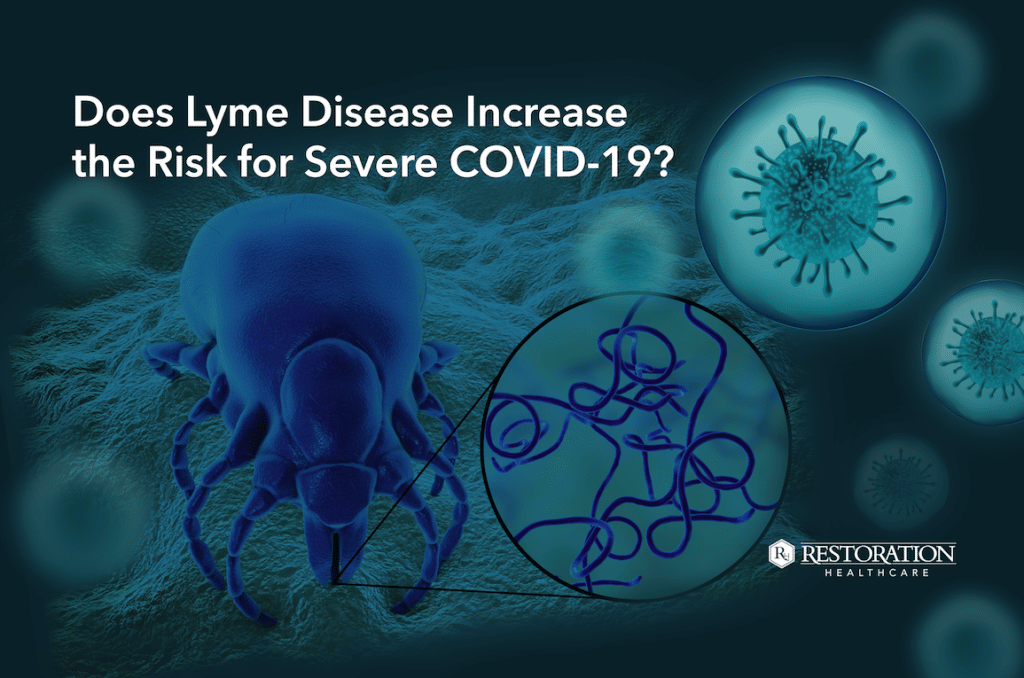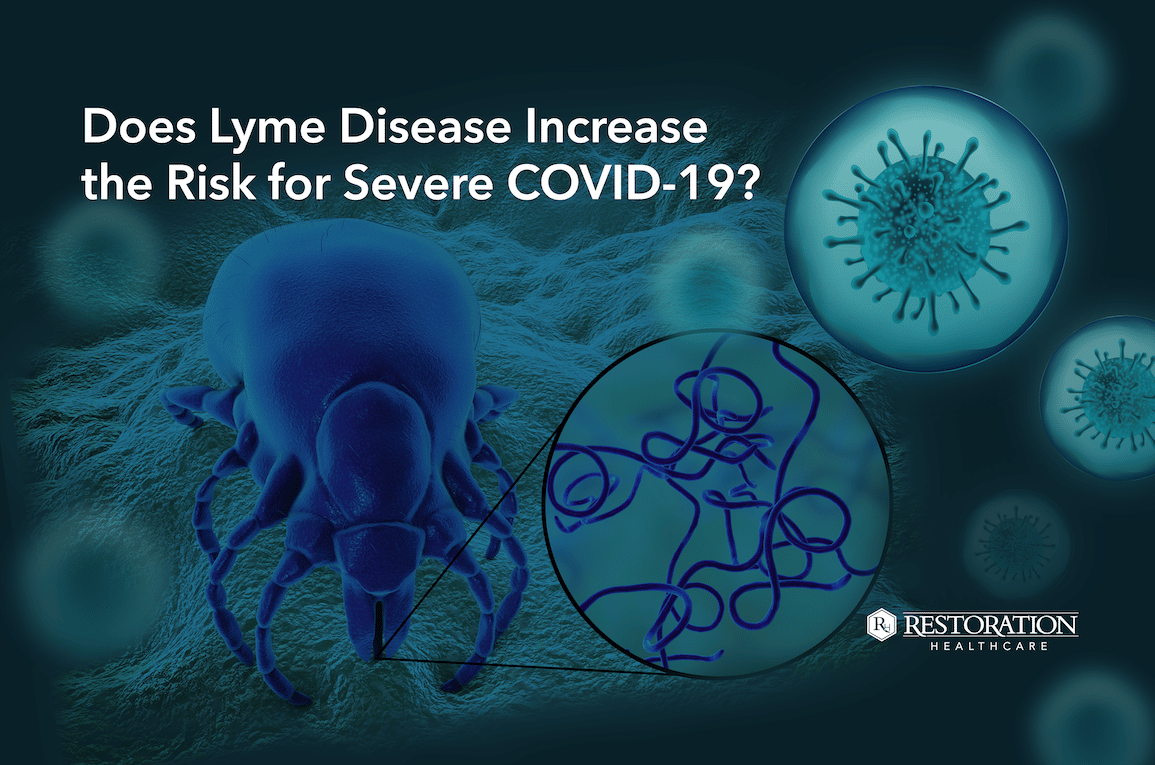Does Lyme Disease Increase the Risk for Severe COVID-19?

Understandably, many of our patients with Lyme disease are concerned that having the disease might increase their risk of being infected by the coronavirus or experiencing severe symptoms of COVID-19 (the disease the virus causes). After all, many comorbid (co-existing) health conditions have proven to increase the severity of COVID-19 symptoms, including being in an immunocompromised state (having a weakened immune system), and people with Lyme disease certainly fit in that category.
The biggest concern is the possibility that COVID-19 will add fuel to an already existing fire for people with Lyme disease. Those who have the worst cases of COVID-19 (as well as people who contract Lyme disease) sometimes experience what is referred to as a cytokine storm — an over-the-top immune reaction during which the body releases too many cytokines (inflammatory, infection-fighting chemicals) into the bloodstream too quickly, attacking not only the virus but also the body’s own organs.
A cytokine storm causes severe inflammation throughout the body that can some instances lead to multiple organ failure and even death. Because Lyme disease weakens the immune system and causes inflammation (and can trigger a cytokine storm), people with Lyme disease have good reason to be concerned about COVID-19.
For these patients, we have good news and bad news. First, the bad news: Lyme disease and COVID-19 are similar in many ways.
Lyme Disease and COVID-19 Connections and Similarities
One of the problems with Lyme Disease and COVID-19 is that you can increase your exposure to one by trying to avoid the other. For example, learning that COVID-19 is less likely to be spread from person to person outdoors, people are spending more time hiking and camping in the great outdoors, possibly increasing their exposure to the ticks that carry Lyme disease. And people who spend more time inside to avoid ticks and other disease-carrying insects increase their exposure to the coronavirus, unless, of course, they choose to spend their entire time indoors in total isolation, which as we covered in The Impact of Social Isolation on Brain Health, isn’t healthy, either.
But that is not the only way Lyme disease and COVID-19 are related.
How They Are Spread
Lyme disease and COVID-19 are both zoonotic diseases, meaning they are caused by germs spread from animals to people. However, Lyme is transmitted mainly from ticks, and can also be transmitted through other insect bites, whereas COVID-19 originated in bats (we think) and can now be transferred from one human to another via respiratory droplets produced when a person coughs or sneezes. Both Lyme and COVID-19 are spreading around the world, though COVID-19 spreads much faster.
One of the major differences between the two is that Lyme disease is caused by a bacterium called Borrelia burgdorferi, whereas COVID-19 is caused by a coronavirus called SARS-CoV-2, which is short for severe acute respiratory syndrome coronavirus 2.
Lyme Disease and COVID-19 Symptoms
Lyme disease and COVID-19 also share many symptoms, which can range from mild to severe and even life threatening. The table below highlights the similarities and differences among symptoms.
Most Lyme and COVID-19 cases begin with flu-like symptoms including fever, chills, sweats, muscle aches, fatigue, nausea, and joint pain. Those with COVID-19 typically go on to develop a cough and respiratory symptoms, whereas the classic symptom of Lyme disease is the target-shaped rash around the site of the bite (which does not always appear).
Unfortunately, even after treatment, symptoms of Lyme Disease and COVID-19 can linger, usually due to delays in diagnosis and treatment. According to a peer-reviewed article titled Severity of chronic Lyme disease compared to other chronic conditions: a quality of life survey, approximately 72 percent of patients with chronic Lyme report their health status as poor. Likewise, many patients with COVID-19 continue to suffer various complications after treatment, including severe fatigue, neurological or cognitive problems, and inflammation.
Underdiagnosed
Both COVID-19 and Lyme disease are significantly underdiagnosed for a variety of reasons, mainly that not everyone with these diseases seeks medical care and that the tests for these diseases are not very effective at detecting them. Also, in the case of Lyme disease, many doctors often do not even think to test for it. Even if people do come in for testing, current tests for Lyme disease and for COVID-19 turn up a lot of false negatives.
According to the U.S. Center for Disease Control and Prevention (CDC), the actual number of Lyme cases is about 10 times higher than the number reported, and some experts estimate the actual number of COVID-19 cases to be three to 10 times higher than reported.
Good News for People with Lyme Disease
Now the good news:
- Both Lyme disease and COVID-19 are preventable. Lyme disease can be prevented by wearing protective clothing, using tick repellant, checking for ticks after spending time outside in areas where ticks are common, and other precautions cited in this Lyme disease prevention post here on our blog. COVID-19 can be prevented by wearing a mask, practicing physical distancing, washing your hands frequently, and keeping your hands away from your face.
- Whether you have Lyme disease or COVID-19, early diagnosis and treatment significantly increase your chance of a full recovery.
- Many of the same medications are used to treat Lyme disease and COVID-19, including tetracycline-derived antibiotics (doxycycline and minocycline), which are frontline treatments for Lyme disease. Although they are used primarily as an anti-bacterial, they also have anti-viral, anti-inflammatory, and anti-parasitic properties.
- While we do not actively treat COVID-19 here at Restoration Healthcare, the treatment protocol we follow for Lyme disease may be similar to what some physicians recommend for COVID-19, because both require calming an overactive immune system while strengthening it to fight infection, stabilizing mast cells, and addressing inflammation, which is at the root of many chronic illnesses. As your immune system’s health and function are restored, your body’s ability to fight all infectious diseases, including Lyme and COVID-19, may improve.
- If you are being treated for Lyme disease or COVID-19, the medications prescribed may be helpful for both diseases. Only your physician can tell you this for certain, so be sure to inquire.
- If you are (or have been) treated for Lyme disease, you are already ahead of the general population in regard to COVID-19, because you’re aware of issues associated with immune system dysfunction and inflammation and because of everything you are already doing to treat acute and/or chronic Lyme disease.
Remember, preventing and treating Lyme disease, COVID-19, and other infectious diseases is about more than just preventing and treating illness — it is also, and perhaps more importantly, about restoring health and function to all systems of the body that keep you healthy and fit. The human body is equipped with effective and efficient mechanisms for identifying and eliminating pathogens, but these mechanisms often become overwhelmed by stress, environmental toxins, nutrient deficiencies, harmful foods, stealth infections, and so on. So, while treating serious illnesses such as Lyme disease and COVID-19 is certainly necessary, we also need to shore up body’s own built-in defense mechanisms.
– – – – – – – – –
Disclaimer: The information in this blog post about Lyme disease and a possible increased risk for severe COVID-19, is provided for general informational purposes only and may not reflect current medical thinking or practices. No information contained in this post should be construed as medical advice from the medical staff at Restoration Healthcare, Inc., nor is this post intended to be a substitute for medical counsel on any subject matter. No reader of this post should act or refrain from acting on the basis of any information included in, or accessible through, this post without seeking the appropriate medical advice on the particular facts and circumstances at issue from a licensed medical professional in the recipient’s state, country or other appropriate licensing jurisdiction.



